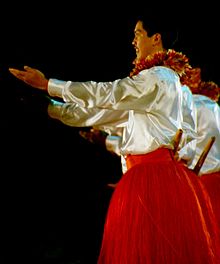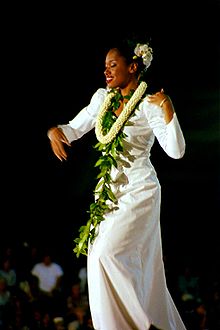- Merrie Monarch Festival
-
The Merrie Monarch Festival is a week-long cultural festival that takes place annually in Hilo, Hawaii. It honors King David Kalākaua, who was called the "Merrie Monarch" for his patronage of the arts. He is credited with restoring many Hawaiian cultural traditions during his reign, including the hula. Many hālau hula (schools), including some from the U.S. mainland and Japan, attend the festival each year to participate in the festival exhibitions and competitions, which are considered the most prestigious of all hula contests.
Contents
History
The festival is dedicated to the memory of King David Kalākaua, the second (and last) elected king of Hawaiʻi, who came to the throne in 1874 and reigned until his death in 1891. He was a patron of the arts, especially music and dance. Kalākaua restored many of the nearly extinct cultural traditions of the Hawaiian people. These included myths and legends, and the hula, which had been forbidden — due to the influence of Protestant missionaries — for over 70 years.[1]
Ancient Hawaiians had no written language. Instead, all communication beyond the spoken word took place in the form of chants and the dance called hula. Hula and its accompanying chants recorded Hawaiian genealogy, mythology, and prayers of the heart and mind. The hula was the means by which the culture, history, stories and almost every aspect of Hawaiian life was expressed and passed down through generations.
Because the Merrie Monarch Festival has maintained strict standards of authenticity, the true history and culture of the ancient Hawaiian people is being perpetuated. Without such educational and cultural organizations as the Merrie Monarch Festival, the history and unique traditions of the Hawaiian people will be lost forever.
Festival activities
The Merrie Monarch Festival was founded in 1964 by George Na'ope. In 1968 the private Merrie Monarch Festival community organization was formed by Dorothy "Auntie Dottie" Thompson who added the competition in 1971.[2]
The annual presentation of the Merrie Monarch Festival has led to a renaissance of the Hawaiian culture that is being passed on from generation to generation. With the exception of 2008, the festival week always starts on Easter Sunday and continues with craft fairs, entertainment, and cultural demonstrations during the week. The festival includes art exhibits, craft fairs, demonstrations, performances, a parade that emphasizes the cultures of Hawaii. The three-day hula competition has received worldwide recognition for its historic and cultural significance.
In preparation of the Merrie Monarch Festival, hula studios and instructors in Hawaii and on the U.S. Mainland hold classes, workshops, and seminars throughout the year to teach the art of hula, the meaning of Hawaiian chants and songs, the Hawaiian language, the making of Hawaiian clothing and crafts, and the history of the Hawaiian people.
Through this ongoing year-round learning process, students also gain a knowledge and appreciation of the unique harmony and balance the ancient Hawaiian people maintained with their island environment. The chants, songs and dance tell stories of the Hawaiians' relationship with nature-the birds and fish, trees and flowers, mountains, oceans, rivers, wind, rain and Hawaii's active volcanoes.
Proceeds from the Merrie Monarch Festival support educational scholarships, workshops, seminars, symposiums and the continuation of the festival.[3]
Hula competition
The festivities culminate in the annual competitions held at the Edith Kanakaʻole Multipurpose Stadium in Hoʻolulu Park. The Miss Aloha Hula solo competition is held on Thursday, and the kahiko (ancient) and ʻauana (modern) hula competitions held on the Friday and Saturday. This is considered by many the Olympics of hula.
There are two divisions of group competition, the male (kane) division and the female (wahine) division. Each halau has up to seven minutes on stage, and during their performance halau are being judged on a variety of things. Just like in the Olympics judges are looking for different elements in each performance. First, there is the entrance (kaʻi), next is the chant (oli), next is the dance (hula) and finally there is the exit off stage (hoʻi). Halau are scored on each aspect of the performance. Up to 30 halau compete each year. The tickets usually sell out quickly.[4]
References
- ^ Schweitzer, Veronica S. (2006). "Merry Monarch Remebered" (in en-US). Coffee Times. Coffee LLC. http://www.coffeetimes.com/apr97.htm. Retrieved 2009-01-19.
- ^ Hilo Culture web site
- ^ About the Merrie Monarch Festival official web site
- ^ Associated Press (April 12, 2009). "Merrie Monarch festival boosts Big Isle economy: The main events at this week's Merrie Monarch Festival sold out months ago". Honolulu Star-Bulletin. http://www.starbulletin.com/news/20090412Merrie_Monarch_festival_boosts_Big_Isle_economy.html. Retrieved 2009-12-18.
External links
- Merrie Monarch Festival official site
- Merrie Monarch Festival photographs
- Merrie Monarch Festival on KFVE live stream, news, and video clips
- Merrie Monarch Festival statistics and information
List of resources about traditional arts and culture of Oceania Art ahu · Australia · Austronesia · Cook Islands · Hawaiʻi · kapa (Hawaiʻi) · lei (Hawaii) · magimagi · Māori · moai · New Zealand · nguzu nguzu · Oceania · Papua New Guinea · reimiro · tā moko · tapa ["masi" (Fiji), "ngatu" (Tonga), "siapo" (Sāmoa), " ʻuha" (Rotuma)] · tabua · ta'ovala · tattoo · tēfui · tivaivaiBroad culture Geo-specific, general Australia · Australian Aboriginal astronomy · Austronesia · Caroline Islands, -Pwo · Chatham Islands · Cook Islands · Easter Island · Fiji, -Lau Islands, -traditions and ceremonies · Guam · Hawaiʻi, -Lomilomi massage · Kiribati · French Polynesia's Marquesas Islands · Marshall Islands, -Stick charts of · Federated States of Micronesia · Nauru · New Caledonia · New Zealand · Niue · Norfolk Island · Palau · Papua New Guinea · Pitcairn Islands · Sāmoa · Solomon Islands · Tonga · Torres Strait Islands · Tuvalu · Vanuatu · Wallis and Futuna · Yap, -navigation, -Weriyeng navigation schoolCanoes Aboriginal Dugout · Alingano Maisu · Drua · Dugout (boat) · Hawaiʻiloa · Hōkūleʻa · Modern Hawaiian outrigger · Māori migration · Outrigger · Polynesian sailing · Proa · Waka,-List of · WalapDance Festivals Australia's Garma Festival · Hawaiʻi's Aloha Festivals, Merrie Monarch Festival, and World Invitational Hula Festival · Fiji · New Zealand's Pasifika Festival · The Pacific Community's Festival of Pacific Arts · Festivals in Papua New GuineaLanguages by areaLanguages of Oceania Sovereign states - Australia
- East Timor (Timor-Leste)
- Fiji
- Indonesia
- Kiribati
- Marshall Islands
- Federated States of Micronesia
- Nauru
- New Zealand
- Palau
- Papua New Guinea
- Samoa
- Solomon Islands
- Tonga
- Tuvalu
- Vanuatu
Dependencies and
other territories- American Samoa
- Christmas Island
- Cocos (Keeling) Islands
- Cook Islands
- Easter Island
- French Polynesia
- Guam
- Hawaii
- New Caledonia
- Niue
- Norfolk Island
- Northern Mariana Islands
- Pitcairn Islands
- Tokelau
- Wallis and Futuna
by categoryLiterature Literature of Oceania Sovereign states - Australia
- East Timor (Timor-Leste)
- Fiji
- Indonesia
- Kiribati
- Marshall Islands
- Federated States of Micronesia
- Nauru
- New Zealand
- Palau
- Papua New Guinea
- Samoa
- Solomon Islands
- Tonga
- Tuvalu
- Vanuatu
Dependencies and
other territories- American Samoa
- Christmas Island
- Cocos (Keeling) Islands
- Cook Islands
- Easter Island
- French Polynesia
- Guam
- Hawaii
- New Caledonia
- Niue
- Norfolk Island
- Northern Mariana Islands
- Pitcairn Islands
- Tokelau
- Wallis and Futuna
Music Austral Islands (French Polynesia) · Australia · Austronesia · Cook Islands · Easter Island · Fiji · Guam · Hawaiʻi · Kiribati · Lali · Māori · Melanesia · Northern Mariana Islands · Micronesia · Federated States of Micronesia · Nauru · New Caledonia · New Zealand · Niue · Palau · Papua New Guinea · Polynesia · Sāmoa · Slit drum · Solomon Islands · Tahiti · Tokelau · Tonga · Tuvalu · Vanuatu · Wallis and FutunaMythology Australian Aboriginal · Fijian · Māori · Melanesian · Menehune · Micronesian · Oceanian legendary creatures · Polynesian · Rapa Nui · VanuatuPeople Indigneous Australian · Austronesian · Chamorro · Chatham Islander (Moriori or Rekohu) · Fijian · Hawaiian (kānaka maoli) · Māori · Marshallese · Melanesian · Micronesian · Negrito · Norfolk Islander · Papuan · Polynesian · Indigenous Polynesian (Mā’ohi) · Rapanui · Rotuman · Samoan · Tahitian · Tongan · Torres Strait IslanderReligion Religion in Oceania Sovereign states Dependencies and
other territories- American Samoa
- Christmas Island
- Cocos (Keeling) Islands
- Cook Islands
- Easter Island
- French Polynesia
- Guam
- Hawaii
- New Caledonia
- Niue
- Norfolk Island
- Northern Mariana Islands
- Pitcairn Islands
- Tokelau
- Wallis and Futuna
Not included: Oceanian: cinema, (indigenous) currency, dress, folkore, cuisine. Also see Category:Oceanian culture. Categories:- Festivals in Hawaii
- Hawaii County, Hawaii
- Polynesian festivals
- Dance festivals in the United States
- Recurring events established in 1964
- Cultural festivals in the United States
Wikimedia Foundation. 2010.



